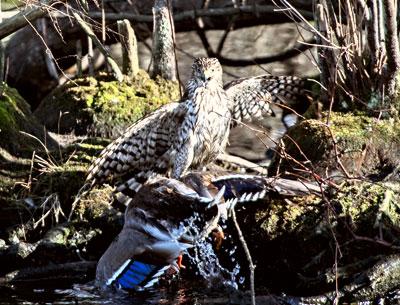Nature Notes: Carolina in the Morning

It was gently snowing with big and little flakes on Monday morning when I went into the living room with my coffee to see if Noyac Bay had frozen yet. I was greeted by a flutter as something whizzed past my head and ended up on top of one of the Venetian blinds where it twitched nervously. The twitching little body, white stripe over the eye, and cocked tail gave it away immediately — a Carolina wren. Poor thing, it didn’t like the freezing cold and falling snow any more than I did.
Some seven years ago the same thing happened. A Carolina wren popped in and sang its shrill repetitious song. Inside my house the song was as loud as the helicopters that fly over, but, I’ll admit, much more melodious. The wren was setting up its territory, as Carolina wrens often nest in old sheds, barns, under decks, and the like. After all, the little guys are from the deep South; they don’t enjoy the cold. That time I merely opened the door to the outside and he flew out. In this last case, I hesitated. It was nasty out, but I made a tough decision, the wren would probably fare better outside than in. I opened the front door and he flew out with gusto.
That’s the chance you take if you’re a southern species and you’re pioneering in the north country. Of the several American bird species that have extended their range to the upper latitudes during the last century (and are full-time residents), the Carolina wren is the smallest and most likely to succumb to frigid Januarys and Februarys. Indeed, there are years when the various Long Island Christmas bird censuses only pick up one or two of this bird.
By the turn of the 21st century, these southerners had become more ubiquitous than many of those winter inhabitants that turned up on the first Christmas bird counts almost 100 years ago. The mockingbird, the cardinal, the white-breasted nuthatch, red-breasted woodpecker, and the Carolina wren would be only very rarely encountered when I was a boy growing up on Long Island in the 1940s.
And it wasn’t global warming that invited them northward. It was the natural bent of all species to further themselves and their numbers, just as we humans have come to occupy every inch of continental land and almost every island across the face of the earth and now number more than 7 billion. A species that is not expanding is on the way to extinction. These birds came first and then it got warmer.
Birds in deep southern climes breed all year round. They sing all year round. It is no coincidence then, that our local mockingbirds, cardinals, and Carolina wrens sing their territorial and courting songs in the winter as if they were still in the southlands.
One February morn in my final semester at Cornell University in Ithaca in 1961, I was awakened by the lucid monotonal notes of a male cardinal singing outside my married-student housing window. Then I heard the same notes coming from inside. I got up, looked, and found that the inside whistles were coming from my 15-month-old daughter, Angela. Lying in her crib on her back, she was dueting with the red bird outside her window, and the red bird was answering back accordingly.
I tend to be a stay-at-home, but many humans are pioneers in spirit. Americans from Europe went west in their new country long before Horace Greeley told them to do so. Some birds are the same way. The finches that got to the Galapagos Islands in the South Pacific came east from the South American mainland. For a while they had the island chain all to themselves and so they radiated into several different species, each one developing a different niche, as Darwin so precisely described in the middle of the 19th century.
We call today’s adventurous humans trekkers. They are always on the move, going there, going here. One or two don’t return after each trip. They settle down far from home and become stay-at-homes like me.
As for the Carolina wren, “Nothing could be finer than to be in Carolina in the morning,” unless it is to be in Sag Harbor in the summer after successfully outlasting another difficult winter.
